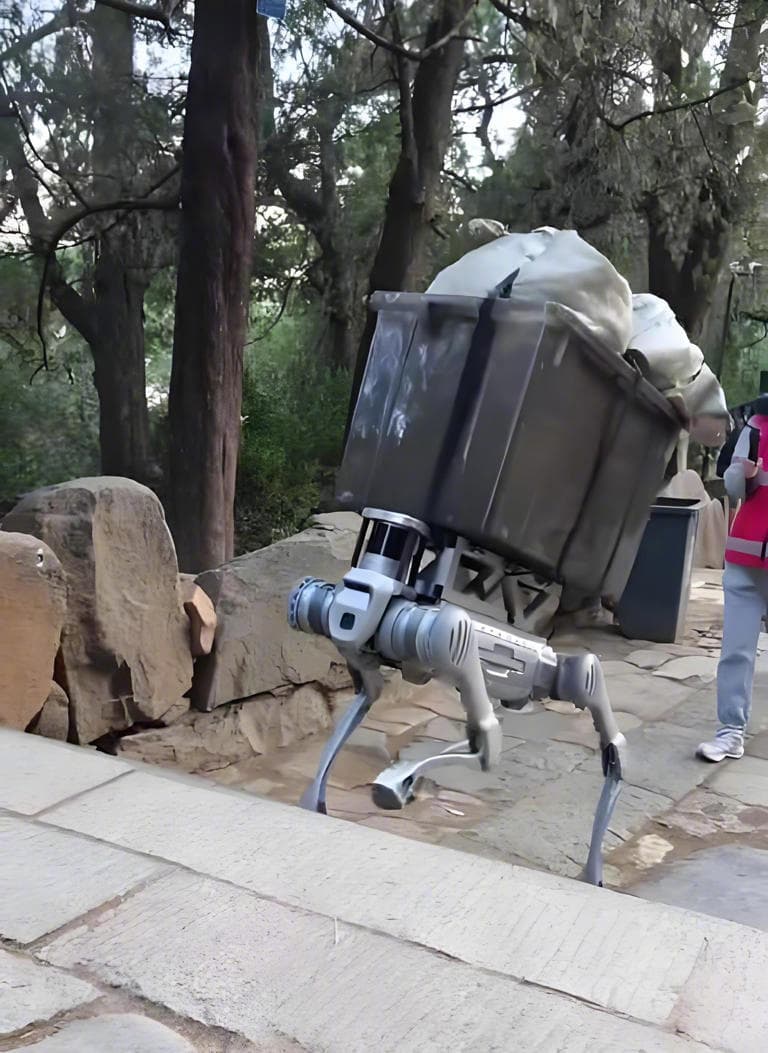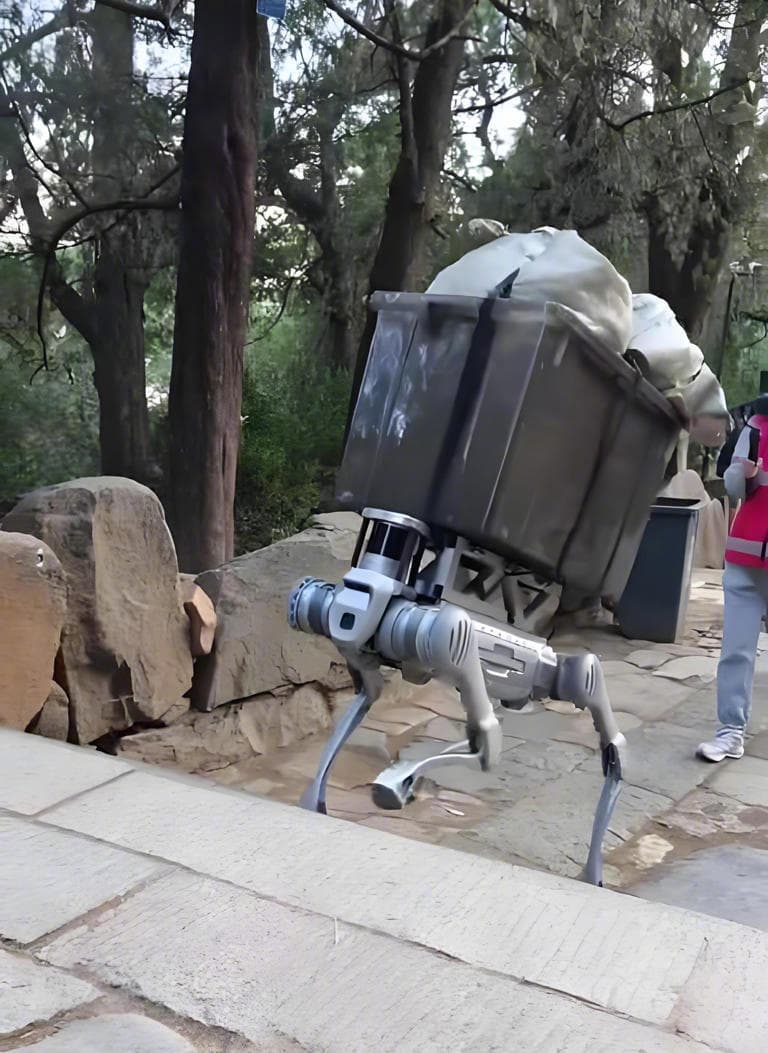Robotic Dog Successfully Tests Garbage Collection on Taishan Mountain
In a groundbreaking trial, a robotic dog has been put to the test in the Taishan scenic area to transport trash, demonstrating its exceptional adaptability to rugged terrain and impressive load-carrying capacity. The robotic dog, developed by Hangzhou-based company Unitree, was put through its paces on the eighteen bends of Taishan, a notoriously challenging route with steep inclines and uneven terrain. Despite the difficulties, the robot dog navigated the course with ease, impressing onlookers with its stability and agility.

23 October 2024
Equipped with advanced technology, the Unitree B2 industrial quadruped robot is designed to operate in harsh environments, including wet and slippery surfaces. Its robust build allows it to overcome obstacles with ease, including logs and rocks, and can carry a maximum load of 120 kilograms.
During the test, the robotic dog was controlled by a staff member wearing a red vest, who guided it as it climbed the mountain while broadcasting messages to remind tourists to protect the environment. The robot's performance has generated widespread interest, with many onlookers expressing amazement at its capabilities. One tourist from Harbin even took a photo with the robot, praising its "magical" abilities.
The machine dog boasts a range of features that enable it to excel in navigating complex terrain, including exceptional stability, impressive obstacle-crossing capabilities, and robust payload endurance. This allows it to traverse challenging environments with ease, effortlessly overcoming hurdles that would impede human or other machines. The UnitreeB2 industrial quadruped robot, the specific model used in the Tai Mountain trash collection test, showcases remarkable adaptability in various environments, including wet, slippery, or extreme terrain. Its powerful motors and advanced algorithms enable it to smoothly navigate through obstacles such as woodpiles and 40-centimeter-high ledges.
Additionally, this machine dog has a strong payload capacity, with a maximum static load of 120 kilograms, and can operate for 4 to 6 hours on a single charge. This robustness, combined with its ability to navigate challenging terrain, positions it as an ideal solution for scenarios like the Tai Mountain trash collection challenge. However, during the test on the treacherous 18 steep turns of Tai Mountain, the machine dog's stability was slightly compromised due to the slope exceeding 45 degrees. Furthermore, some issues were identified, such as the design of the cargo container and the inadequate sealing of garbage packaging.
Taishan Scenic Area's complex terrain has long posed a significant challenge to garbage collection, with its steep slopes and narrow paths making it difficult for traditional garbage trucks to navigate. As a result, garbage collection has often relied on manual labor, which is not only time-consuming but also labor-intensive. During peak tourist seasons, the sheer volume of garbage generated has often led to difficulties in collection, resulting in unsightly garbage piles and environmental degradation.

The introduction of robot dogs, such as the UnitreeB2 industrial quadruped robot, offers a promising solution to this problem. Equipped with advanced navigation systems and a robust design, these robot dogs can easily traverse the complex terrain of Taishan Scenic Area, collecting garbage with ease. With a maximum payload capacity of 120 kg and a continuous operation time of 4-6 hours, these robot dogs can significantly improve the efficiency of garbage collection in the area.
Moreover, the robot dogs' ability to navigate steep slopes and rough terrain makes them an ideal solution for areas inaccessible to traditional garbage trucks. As seen in the recent testing at Taishan Scenic Area, the robot dogs can effortlessly climb the 18th bend, a notoriously steep slope, while collecting garbage and providing voice reminders to tourists to protect the environment. While some issues have been identified during testing, such as the need for improved cargo storage design and better garbage packaging, the overall potential of robot dogs in solving the garbage collection challenges in Taishan Scenic Area is undeniable.
The emergence of robotic dogs like the one tested on Mount Tai sparks a deeper reflection on the trajectory of technological advancements and their impact on society. As machines increasingly assume roles traditionally held by humans, it's essential to reexamine the relationship between humans and technology. While robotic dogs may bring a sense of excitement and innovation, it's crucial to consider whether they truly enhance our lives or pose unforeseen challenges.
The integration of machines into our daily lives raises important questions about the future of work, leisure, and human interaction. On one hand, automation and AI-powered technologies can bring about unparalleled efficiency, productivity, and convenience. However, they also risk displacing human workers, exacerbating social isolation, and creating new dependencies on technology.
Furthermore, the development of machines that can navigate complex environments like Mount Tai highlights the need for responsible innovation and consideration of the environmental impact of technological advancements. As robots become more prevalent, it's essential to ensure that their production, deployment, and disposal do not contribute to the very problems they aim to solve.
Ultimately, the future of technology is a double-edged sword, offering immense potential for progress and innovation while also posing significant challenges. As we continue to push the boundaries of what is possible with machines, it's crucial to engage in ongoing discussions about the ethics, consequences, and benefits of these advancements, ensuring that they align with human values and promote a better future for all.
Comments

Share this article
Related Articles

Alipay Users Rush to Revoke Permissions Over Hidden Authorizations, Sparking Nationwide Privacy Debate
By Trending on Weibo
Tech
15 Sept 2025

Pinduoduo’s “Journey to the West” Campaign Delivers Free Shipping to China’s Remote Western Provinces.
By Trending on Weibo
Tech
12 Sept 2025

Apple’s iPhone 17 Pro Camera Ignites an Industry Arms Race, Democratizes Visual Storytelling, and Fuels Privacy Debate.
By Trending on Weibo
Tech
12 Sept 2025

Huawei Launches World’s First Mass‑Produced Tri‑Fold Smartphone, the Mate XT, Sparking a Premium Market Shake‑Up
By Trending on Weibo
Tech
12 Sept 2025

Jackson Wang Films “Let Loose” Music Video Entirely on Apple’s iPhone 17 Pro, Highlighting Mobile Filmmaking Power】
By Trending on Weibo
Tech
11 Sept 2025

